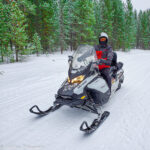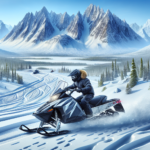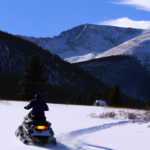Imagine yourself cruising through a winter wonderland, your snowmobile whirring underneath as you navigate shifting landscapes effortlessly. But, one does not simply hop onto a snowmobile and ride off into the horizon. To capture this exhilarating experience, you need to understand the ropes to operating it. In this regard, this article will provide step-by-step guidelines on how to operate a snowmobile successfully and safely.
Understanding The Basics
It’s essential to understand that snowmobiling is more than just a fun winter activity. It’s also a mode of transportation for many people living in snow-prone areas. So, why operate a snowmobile? It allows you to navigate through the winter landscape easily, offering thrilling adventures and picturesque views. But before hopping onto one, it is crucial to understand which type of snowmobile fits your purpose.
Why Operate a Snowmobile?
Operating a snowmobile not only presents a unique and thrilling way to traverse snow-covered landscapes, but it can also provide access to areas that are off-limits during the winter season for ordinary vehicles. Whether you are an adrenaline junkie seeking some outdoor thrill or someone who wants to enjoy undisturbed winter landscapes, snowmobiling is an exceptional winter sport that offers this and more.
Common Types of Snowmobiles
Understanding the different types of snowmobiles is critical in determining which will serve your purpose best. There are primarily three types: trail, utility, and mountain snowmobiles. Trail snowmobiles are ideal for easy gliding on well-maintained paths whereas, utility snowmobiles are designed for heavy-duty tasks in snowy conditions such as hauling cargo or people. On the other hand, mountain snowmobiles are specially designed for climbing steep and deep snow-covered slopes with their lightweight, long, and narrow chassis.
Safety Precautions and Equipment
Your safety is paramount when operating heavy machinery like a snowmobile. Always wear protective apparel, including a helmet, goggles, snow boots, gloves, and a snowsuit. Avoid riding on unmarked trails or frozen bodies of water, and always check weather forecasts before heading out. Carry a first aid kit, map, and emergency supplies.
Familiarizing Yourself with the Snowmobile
Before heading off into the winter wonderland, familiarize yourself with different parts and their functionalities.
Parts and Functions of a Snowmobile
A typical snowmobile consists of a drive belt, engine, braking system, steering skis, and a suspension system. The drive belt transfers power from the engine to the tracks, propelling the snowmobile forward. The steering skis guide the snowmobile, and the brakes are for stopping the machine. The suspension system absorbs impact, providing a smoother ride.
Understanding the Control Panel
Understanding the control panel is crucial. Typically, it includes a start button or key ignition, a throttle to control speed, and a brake lever. Some snowmobiles may also have gauges displaying speed, fuel level, and engine temperature. Ensure you comprehend these controls before setting off on your adventure.
Identifying Safety Features
Most snowmobiles are equipped with various safety features to protect riders. Some essential features include headlights and taillights for visibility, handguards to protect from cold and flying debris, and a kill switch to immediately turn off the engine in case of an emergency.
Preparing to Ride
Before riding, it’s important to check your snowmobile’s condition, start it properly, and test the controls.
Checking Your Snowmobile’s Condition
Inspect your snowmobile’s overall condition before each ride. Check the fuel and oil levels, inspect the condition of the drive belt, and ensure that the headlights, taillights, and brake lights function properly.
Starting the Snowmobile
To start a snowmobile, make sure it is on a flat surface. Then, turn the key or press the start button. Allow the engine to warm up before embarking on your journey.
Testing the Controls
After starting the snowmobile, test the throttle and brake controls. Make sure the brake can easily stop the snowmobile, and the throttle responds correctly when pressed and released.
Getting on the Snowmobile
Mounting and maintaining balance on the snowmobile is crucial to maintaining control and safety.
Climbing onto the Snowmobile
To mount the snowmobile, face it, grab the handlebars and step onto the sled using the footrest.
Maintaining Balance on the Snowmobile
Keeping your balance when riding is essential. Always keep your feet on the footrests and your hands on the handlebars. Center your weight, lean slightly forward, and adjust your weight according to the terrain and speed.
Practicing Safety Measures before Starting
Before starting, ensure you are aware of all safety measures. Always wear your safety gear, take along a first aid kit, and ensure you are familiar with the snowmobile safety features.
Operating the Snowmobile
Once you’ve familiarized yourself with the vehicle, it’s time to understand acceleration, deceleration, braking and turning.
Accelerating and Decelerating
To accelerate, gradually squeeze the throttle lever, usually located on the right-hand side of the handlebar. To decelerate, release the throttle lever gently.
Understanding and Using the Brake System
The brake lever is located on the left handlebar. To use it, simply squeeze the lever towards the handlebar. Brakes work best when applied gradually and evenly.
Handling Left and Right Turns
To turn, shift your body weight toward the direction you wish to go and slightly turn the handlebars in the same direction. But remember, turning too fast can cause the snowmobile to roll over.
Overcoming Common Challenges
As with any vehicle, snowmobilers can face challenges relating to visibility, terrains, and technical issues.
Dealing with Poor Visibility
In poor visibility situations, slow down and consider turning on your snowmobile’s high-beam lights. Always keep a safe distance from other vehicles and avoid unfamiliar trails.
Managing Difficult Terrains
Steeps slopes, uneven ground, and areas with deep snow present challenges. Maintain balance, adjust your speed accordingly, and keep your gaze ahead to anticipate changes.
Handling Potential Technical Issues
With regular maintenance, most technical issues can be avoided. However, if you face a problem out there, don’t panic. Check the basics – oil and fuel, belt condition, lighting system, and if nothing seems to work, seek professional help.
Mastering Advanced Techniques
As you become more comfortable with your snowmobile, you might want to learn some advanced techniques.
Performing Jumps and Tricks
While it’s fun to perform jumps and tricks on a snowmobile, it’s essential to practice with caution. Always wear your protective gear, choose your jumps carefully, and make sure you have a clear landing space.
Navigating steep slopes requires practice and skill. Always approach at an angle, keeping your weight uphill and the sled under control at all times.
Riding at High Speeds Safely
Riding at high speeds brings excitement, but it’s also where most accidents happen. Ensure that visibility is good, you’re comfortable with the trail, and keep enough distance from others to react to sudden stops or turns.
Snowmobile Maintenance and Care
A well-maintained snowmobile not only provides a safe ride but is also likely to last longer.
Regular Inspections and Care
Consistent inspections and proper care keeps a snowmobile in top condition. Clean it after every ride, inspect the engine, brakes and belt, and ensure all lights work properly.
Diagnosing and Fixing Common Issues
With time, you’ll be able to diagnose and fix minor issues like changing the drive belt or replacing burnt out bulbs. Regular maintenance allows you to spot potential problems early.
Understanding When to Seek Professional Services
Remember, while you can manage smaller maintenance tasks, it’s wise to seek professional services when the issue is beyond your expertise. Regular professional service checks ensure your snowmobile stays in its best condition.
Understanding Snowmobiling Etiquette
Snowmobiling involves not just operating the machine, but also understanding and respecting the unwritten rules of the trail.
Following Trail Signs and Rules
Following trail signs and rules ensures everyone’s safety. Always stay on the marked trail, respect the right of way and keep your speed within the limit.
Respecting Other Riders and Snowmobilers
Be courteous to others on the trail. Slow down when meeting other sledders, don’t block the trail if you stop and always offer help if you come across someone in trouble.
Minimizing Environmental Impact
As a responsible snowmobiler, it’s your duty to minimize impact on the environment. Stay on marked trails, don’t litter, and respect local wildlife.
Understanding Snowmobiling Laws and Regulations
Snowmobiling laws and regulations vary from place to place, so it’s essential to familiarize yourself with those in your area.
Licensing Requirements
Most regions require a valid license to operate a snowmobile. It’s essential to understand these requirements and follow them strictly.
Riding Restrictions and Boundaries
Certain areas may have restrictions on where you can ride. Familiarize yourself with these boundaries and respect them to avoid penalties or harming the environment.
Penalties for Law Violations
Violating snowmobiling laws can result in fines, suspension of licenses, and sometimes even imprisonment. Always adhere strictly to all laws and regulations for safe and hassle-free snowmobiling.
By understanding these basic principles and safety precautions, you’re now ready to enjoy the thrilling adventure that snowmobiling offers. Remember, the key to a great snowmobiling experience is safety, respect for others and the environment, and proper care of your machine. Have fun out there!
- What Snowboard Bindings Should I Get? - January 23, 2024
- What Size Screws For Snowboard Bindings? - January 23, 2024
- How To Snowmobile On Water? - January 23, 2024










